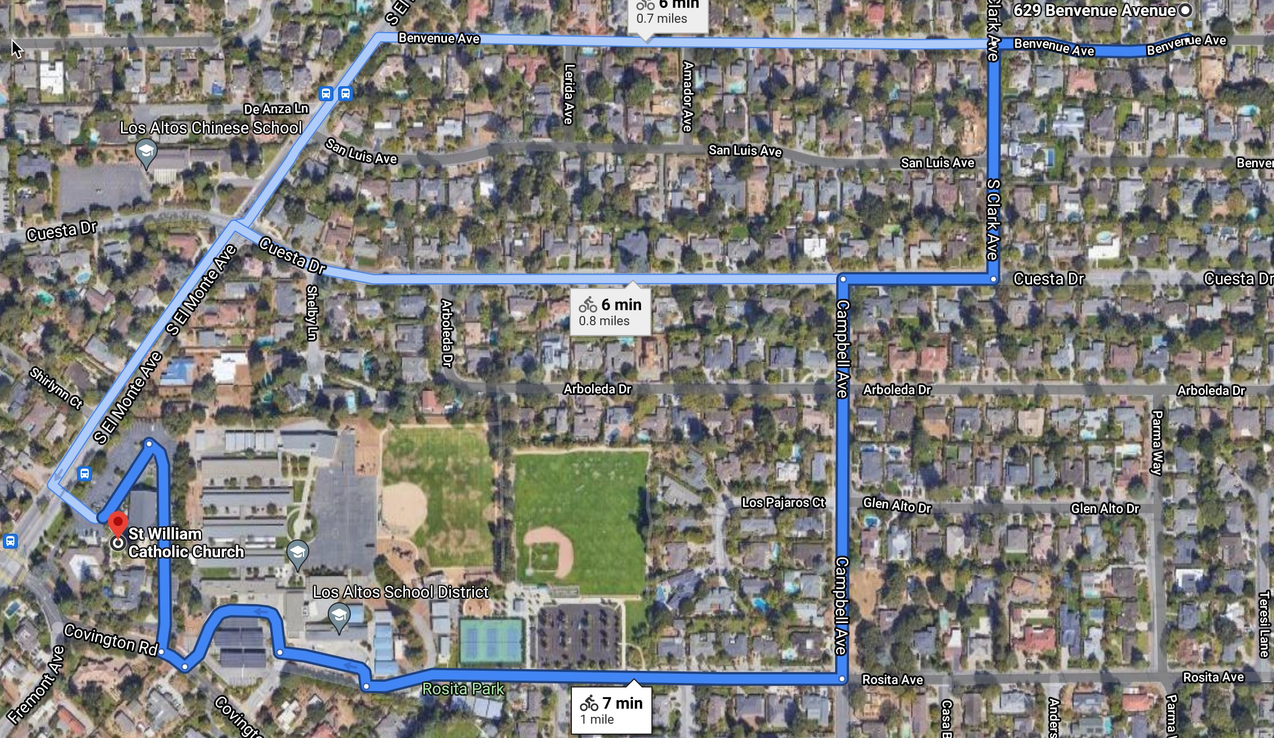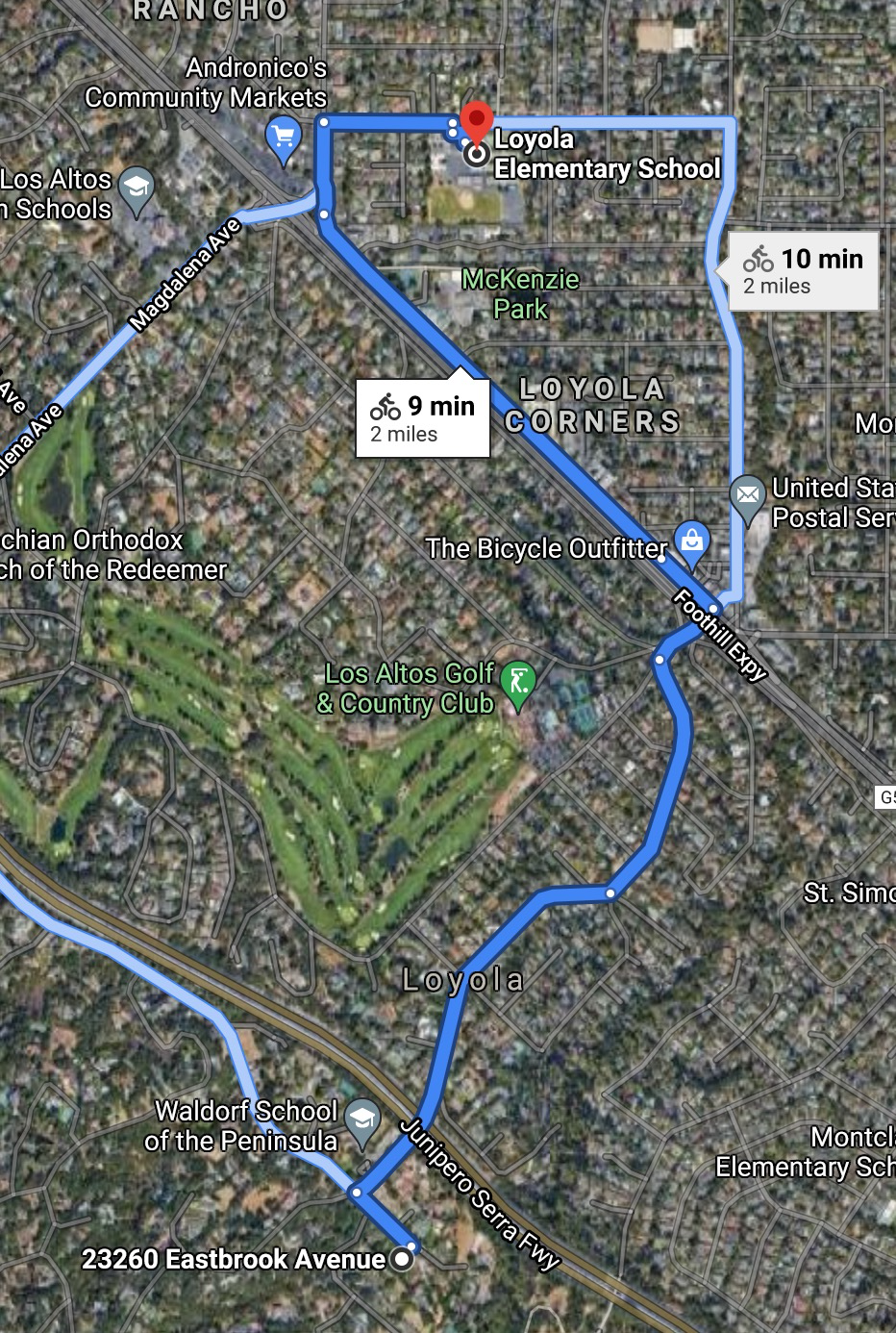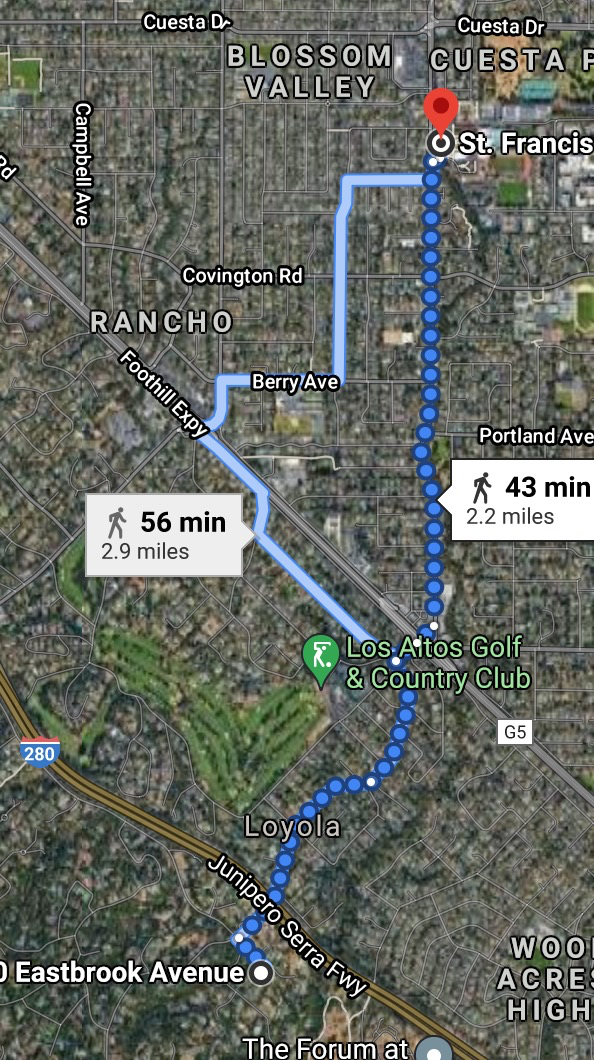Tag: Los Altos
50s: Nomads
We moved around in the early fifties. I was born in Milford MA where my Dad’s family had lived for generations. He was a doctor in general practice at that point. Mom and Dad met in uniform, doctor and nurse, during the war. They married in 1945 and had Chip in 1946, me in 1948. We were a classic baby boom family.
After Milford we were in Fort Pickett VA because Dad got drafted into the army for the Korean War. I remember late-night phone calls, Mom and Dad worried. I learned later that because Dad had served during World War II he wasn’t supposed to have to serve again during Korea. But he lost that argument, and we lived in a small house on the base, looking out over a big field to a forest. Mom and Dad told the story of Dad being called to testify in Washington about the injustice of having to serve twice. They met Senator John F. Kennedy in the halls, and Dad liked to tell the story that he asked to meet Mom. She was beautiful, he was a womanizer.
Then we moved to Park Forest, IL. It was a socially designed suburb of Chicago, which was used later for research into the phenomenon of suburbs in the 50s. We moved there for Dad to become an ophthalmologist. Dad took a train into Chicago every weekday. Mom was a fifties housewife with two small boys. We lived in a cul-de-sac and the tiny kids played in the street while their mothers watched. I know this from stories, not from memory. I was too young.
and from there, they moved to California. They had seen California during the war, and they knew they wanted to settle there. Mom told us about arriving in California for the first time, during the war, in February. She’d been all night in the train and woke up in Los Angeles. The warmth, the deep blue sky, the flowers everywhere left her impressed for good. That dynamic fueled the growth of California after the war. People from elsewhere wanted to move there for its landscape and climate.
I heard stories of plane rides from Chicago to California. The planes were propeller planes. There was a stop for fuel halfway between Chicago and San Francisco.
We lived for a while in Marysville CA. I started kindergarten in Ojai CA. And then Los Altos.
We moved to Los Altos in 1953. It was a nice small town on the San Francisco Peninsula, on the edge of the Santa Clara Valley. The valley was also called Blossom Valley mainly for its apricot orchards spreading through the southern parts of Palo Alto, the flats of Los Altos and Mountain View, Sunnyvale, down past San Jose, which was the main town in the valley. That’s the same valley that’s now called Silicon Valley.
We lived at 629 Benvenue Ave, a rented house on a cul-de-sac, thoroughly fifties middle class America. I learned later that two forty-niners (pro football) lived on the same street. They were like the rest of us, living in flat suburban houses in the suburbs.
1954: Six-Year-Olds Biking to School
Me getting to school, as a child in the 50s, was radically different from what we see in 2021.
When I started first grade, at six years old, in 1954, I rode my tiny 20″ bicycle a mile through residential Los Altos streets, in the company of my older brother, Frank (Chip), who was eight years old. Our parents thought nothing of it, as far as I know. It never came up in later conversation. I suppose sometimes when it was raining or something they’d drive us, but I don’t remember that. And I do remember sometimes doing it on my own; but I was only six, so maybe that memory is flawed. We lived at 629 Benvenue Avenue in Los Altos, and St. Nicholas Catholic School was in the buildings that are now St. Williams Catholic Church.

Although this would be highly unusual now, it was commonplace then. Chip and I went to the Catholic school, but that neighborhood was full of kids our age, and the others took their bikes to a nearby public school.
When I was in third grade, we moved to 23260 Eastbrook Ave, also in Los Altos. From then on, Chip and I went to the public school, Loyola Elementary School, which is still a public school today. It’s on Berry avenue. It was two miles by bicycle. The first year or so I took a school bus that would wind up from the school through the hills of Los Altos Hills, above Magdalena Ave. The school was served by five or six different buses, so everybody who lived further than a block or so away could ride the bus if they wanted. The buses were always lined up waiting to go when the final bell rang. I was one of the last to be picked up in the morning, so morning rides were fine; but that meant I was also one of the last to be dropped off in the afternoon, so it was a long trip. It took 45 minutes to get home, so it was boring. By luck of the draw, none of my good friends were on the same bus. So I just looked out the window and waited my turn. The school bus was a classic yellow school bus, owned and operated by the school district.
Sometime within a year or so, maybe even while still in third grade, I was allowed to take my bicycle instead of the bus. That was a two mile ride through mostly residential streets, with a bit along Fremont Ave, a main street. A third grader riding the bike to school, two miles down in the morning and back up a couple of tough hills in the afternoon, was also commonplace.

That was the pattern for me through middle school, which was slightly further, but by then I was in middle school, which was seventh and eighth grade. I rode my bike unless it was raining, in which case I took the school bus through basically the same long winding route. The school bus became more interesting because I did have some friends, and there were a couple girls I liked who took the same bus. Not that we’d flirt, because that would have been embarrassing. But I was a middle schooler, a boy, and proximity to girls, especially some special girls, was way more exciting than I would let on.
By the time I started high school, at Chester F. Awalt High School, bikes were not cool. As with elementary For afternoons I took a long bus ride, about an hour long, through the hills. By that time I’d been with the same kids on basically the same bus route since Loyola, so the social aspects of the bus were a good thing. I can still remember the names of some of the girls who’d ride that bus with me. With fondness. Girls were so exciting … not accessible yet, I was too young for dating, but we could like each other and talk about school and homework. The bus ride wasn’t bad.
Then they switched me to St. Francis, from the public coeducational high school to a Catholic boys high school. Bicycling was still uncool. On rainy days and when I had a reason (some project to carry, for example, or staying after school for activities) they’d let me drive the 1958 Chevrolet station wagon, the third car in the family, to school. That made me proud and happy. But most of the time I walked to school and back, every day, usually with a neighbor kid who was a friend just for the walk, not in school (we had no classes together). That was a 2.2 mile walk each way. It took about 45 minutes.

50s: Suburbia
There were a lot of other kids in that neighborhood. On weekends and during the summer, we’d leave home after breakfast and play with five or more other kids all day, without going more than a hundred yards from home. We played football and baseball on the Cimino’s large front lawn, directly across the street from our house. We played cops and robbers and cowboys and Indians through several yards and on the street. A pause to grab a peanut butter and jelly sandwich at home (I don’t remember any meals shared with the other kids) and then back to play.
We biked to school. I was five when I started first grade with the nuns at St. Nicholas Catholic School, which was where St. Williams church stands now. Chip and I rode our bikes about a mile through Los Altos without any parental concern or neglect. Lots of kids our age rode bikes through town. Biking in Los Altos was safe as long as I was with Chip, my older brother, who was seven.

I had Sister Clarissa to start first grade, but she disappeared after Christmas vacation. The kids said she’d been taken to the loony bin. Sister Clarissa was just fine with some kids and mean as hell with others. I still remember when she slapped the daylights out of poor Patty Vance (who had an obvious disability). She liked me, but she had hated Chip. My parents rolled their eyes, obviously glad to see her go.
Being Catholic was a big deal. We prayed morning and night and went to Mass on Sundays. God and Jesus were always lurking. And you had to pray a lot when you went to sleep, afraid you’d see a nuclear mushroom cloud before morning.
From the first time I heard it, I couldn’t believe that supposedly only Catholics could get into heaven. I asked Sister Judith what about some poor kid in Africa who’d lived a good life … no heaven for him? Nope. Purgatory. Tough luck, kid. And that was the crack in the armor; made me start to doubt.
We also rode our bikes through town to the Los Altos Theater on Main Street for the Saturday matinee. It took a quarter to get in, plus another five cents for popcorn. The matinee would start with a serialized black-and-white episode of Flash Gordon. Our favorites were the Disney movies. I never went alone; always with Chip; often with some of the other kids as well.
50s: Oddly Rural
In 1956, when I was eight, we moved from the flats up into the hills. To Eastbrook Ave. We moved from classic fifties suburb to rural, although less than four miles away. Oddly rural. It was barely half a mile from the Los Altos Golf and Country Club, and a one-mile bike ride to Loyola Elementary School. Five miles to Main Street in Los Altos or to Castro Street in Mountain View. But still, rural.
Eastbrook Avenue was then a one-lane, poorly paved private road that ran a few hundred yards from Mora Drive south southeast to Permanente Creek. It started in a small flat valley just about where the landscape started to rise to the west up to the crest of the coast range at Black Mountain. To the east was an open field of tall weeds, waist high to a kid, for maybe three hundred yards before it rose slightly to an orchard on a hill across the way. To the west, chaparral covered hills rose steeply from our back yard, to coast range tree-covered mountains topped beyond the horizon at Black Mountain, which we heard about, but couldn’t actually see. To our right, if we looked out on the field from our house, the road dropped sharply down a hill to an even smaller valley fed by Permanente Creek, a year-round creek that was never wider than five or ten feet, never deeper than a foot or so in its deepest pools, full of water spiders, frogs, in inch-long fish. There was a house on the other side of the street and down from us, riding the hill. And there were two houses at the bottom of the hill, near the creek. The hill that started in our back yard and dropped down to the creek 200 yards below was a small part of the famous San Andreas fault.
I most often rode my bicycle from there to Loyola School, about a mile. Sometimes I took the long bus ride that wound its way around the hills above and then dropped down Mora Drive to leave me off at the corner. Then I had a short walk down the street with the open green fields to my left and the one other house, before ours, to my right. I remember it with the sky bright blue, the evergreens around the neighbor’s house dark green, the open field a mixture of grass and grain colors, plus highlights of bright yellow when the mustard weeds were open. And when I say skies were bright blue, the field green, I mean real colors, as if you wouldn’t believe them on a postcard picture. We knew about smog, back then, in Los Altos and thereabouts, only because we’d seen it in Los Angeles. We’d driven through Los Angeles in the summer, on the way to Newport Beach, squinting, shocked by the strange haze that blanketed the whole area on summer days, smelling like exhaust and making eyes water. Smog was a local geographic phenomenon limited to Los Angeles. Or so we thought in the Bay Area, 400 miles north of that, blessed by crystal clear blue skies.
When we moved there, I had a sandbox, a yard to play in, a two-year-old brother who often followed me around, and a 10-year-old brother who liked chess and opera. No other kids lived nearby. I chased frogs by the creek, and snakes in the chaparral above us. I kept lizards when I could catch them. I rode my bike to the pet store at Blossom Valley Shopping Center (halfway to Mountain View) and bought white mice and turtles. My best friend from Benvenue would come up for sleepovers occasionally, but I was mostly alone. I liked the sandbox, the back yard, and small cars and trucks. And the creek, and the hills behind the house.
In a year or two, I connected with a couple of other kids near enough to play with in the summer, one of them a first cousin. We explored more of the hills and we practically owned the creek. We built forts, dams, villages with tiny cars, and throwing rocks at water striders.
It is now far from rural, by the way. The unincorporated area we lived in became Los Altos Hills. The hills behind us came to be called Pill Hill because a dozen or so doctors and families built large houses in the new streets where we used to wander through the chaparral. The field gave way to Interstate 280 first, on the far side – billed as a beautiful freeway when it was built, because of the way it wound through the hills above the San Francisco Peninsula – and then to densely packed and sadly pompous big houses that could have been the definition of what they later called Mac Mansions, big fancy houses squeezed uncomfortably into lots that left little room left over for yards proportional to the houses.
As I write this, Dad, now 100, still lives in that same house we moved into in 1956, on Eastbrook Ave. It has a small winery on the lot now. It’s been remodeled twice, and it’s on its third lady of the house. And it’s now surrounded by Silicon Valley glitz and glamor.
